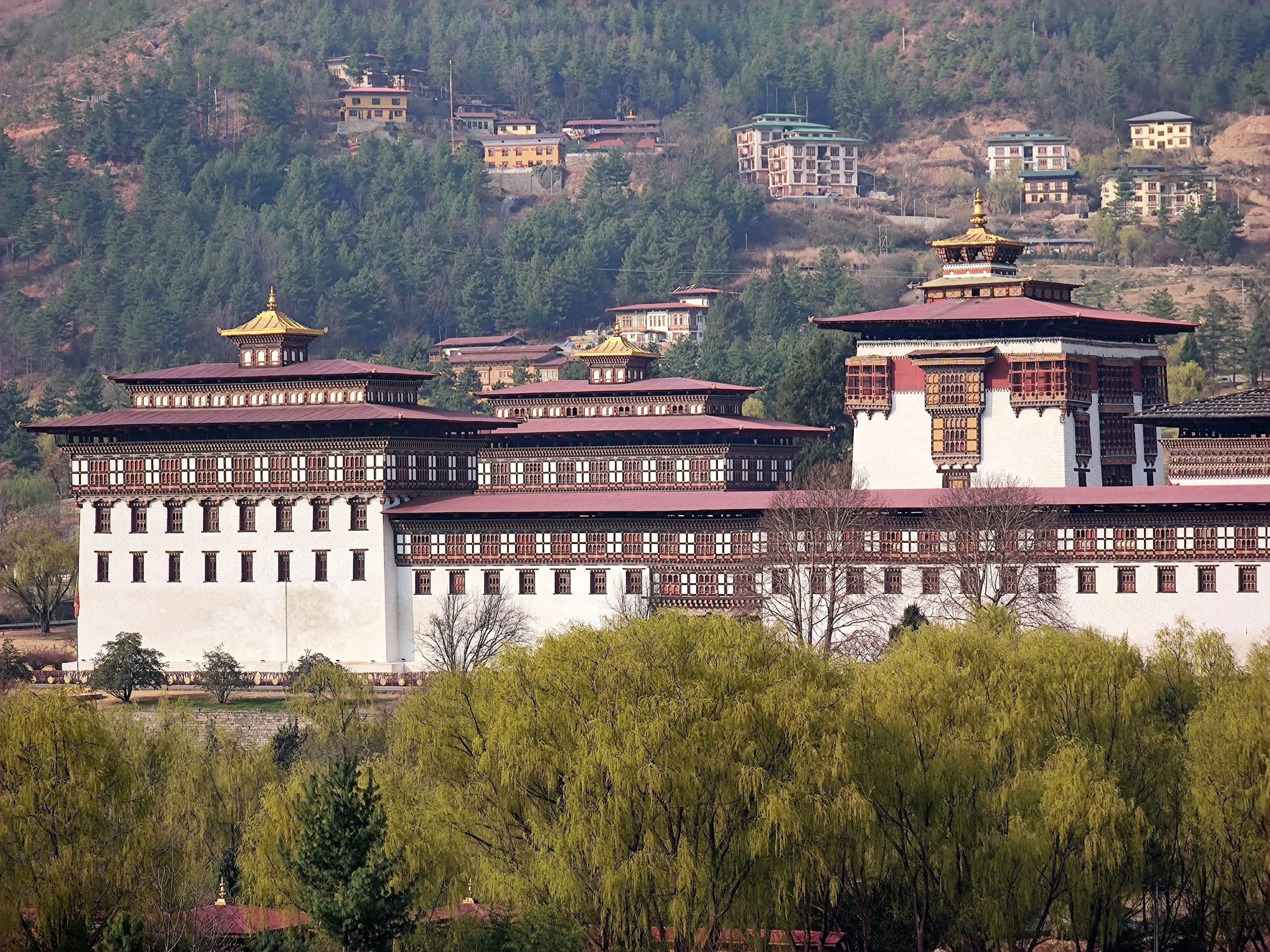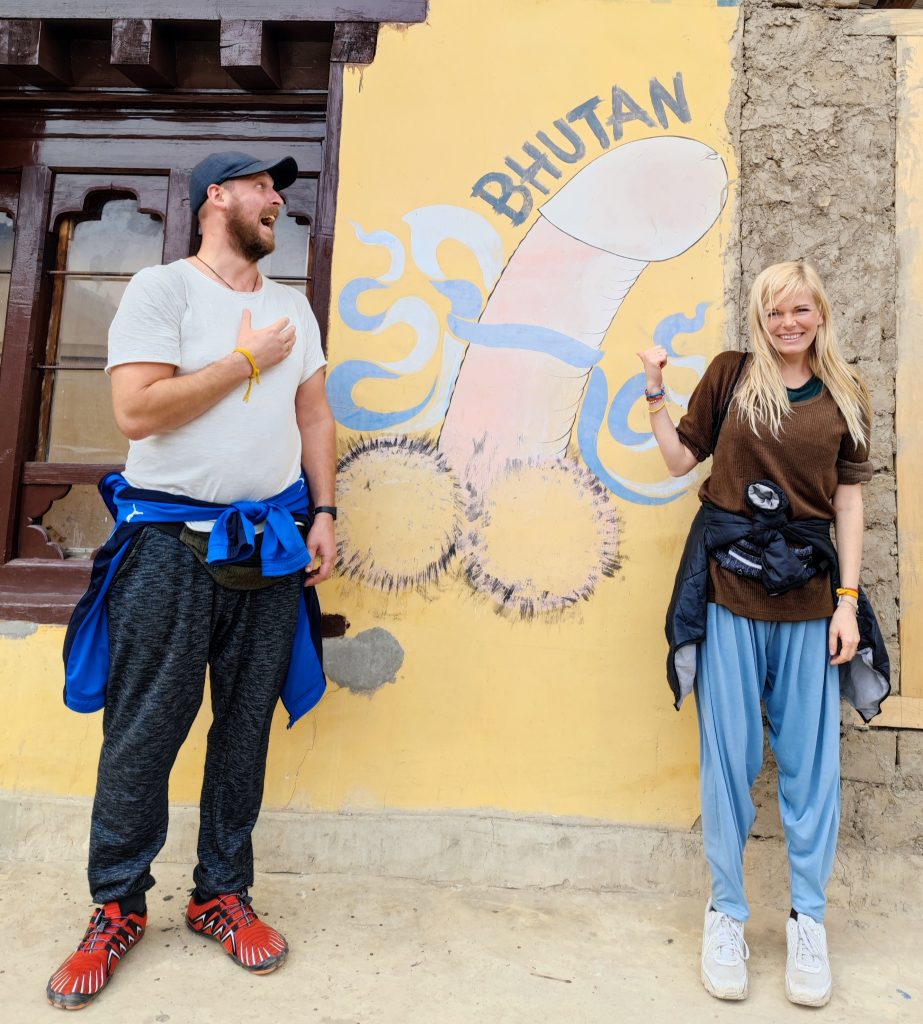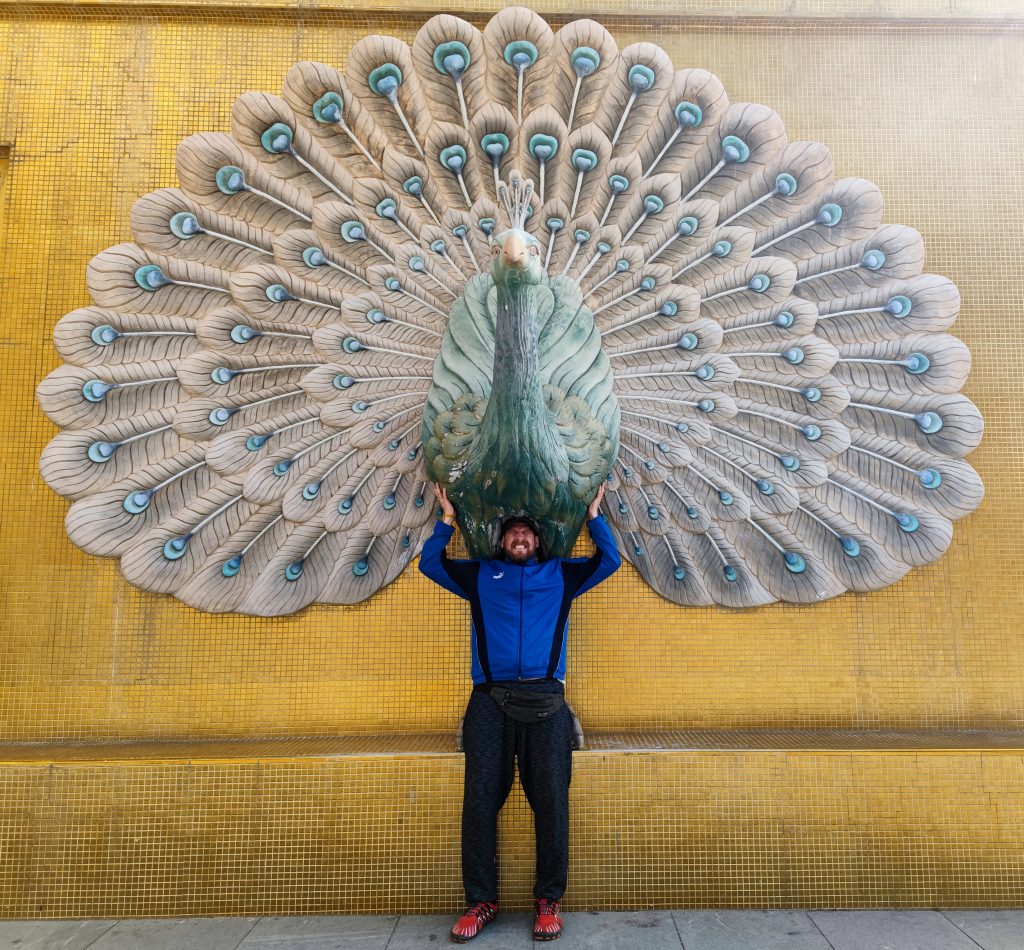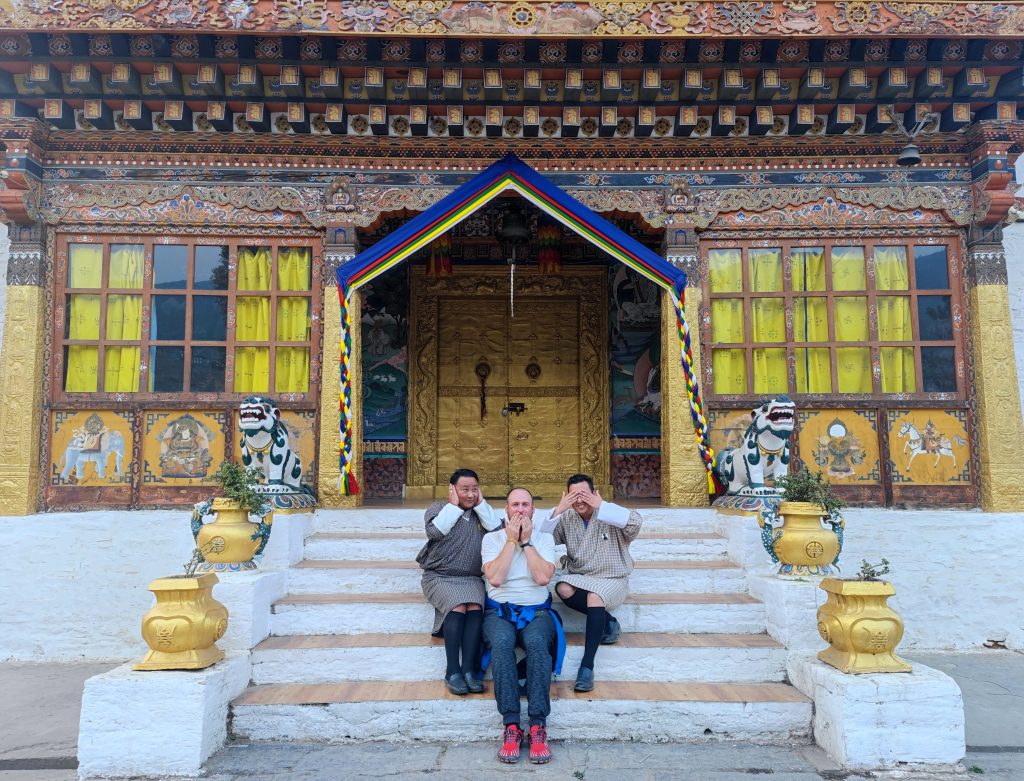
Thimphu and Beyond: Guinness Records and the Unconventional Magic of the Mushroom Temple in Bhutan. Day 2.

How did Bhutan come to be? This small mountainous country has a rich history, with its roots extending back in time. However, it wasn’t until the 17th century that a lama, a Tibetan Buddhist teacher, arrived from Western Tibet and successfully united the small groups of people residing here. Originally known as the “Land of the South” or the “Southern Herbal Medicine Country,” it later evolved into Bhutan. The lama advocated for a dual system of government, erecting fortresses on each hill to accommodate both administration and religious leaders.
The Tibetans followed their Tibetan brethren to Bhutan, triggered by the latter bringing here a relic—a part of a holy man’s spine. Disputes arose, leading to multiple conflicts until a wise lama decided to resolve the issue by throwing the relic into the river. However, he secretly tossed the duplicate. So the piece of the spine, housing the God of Compassion, remained in Bhutan, fostering peace, while the Tibetans never returned.
Our guide, who undergoes an annual guide exam, shared this captivating story. The exam assesses knowledge and the guide’s overall appeal to customers. Ours is exceptionally adept. In Bhutan, it’s mandatory to have a guide to explore fortresses or temples.
Bhutan has never succumbed to conquest, owing to its mountainous terrain and wise kings. The sixth king is now growing up. Though great lamas typically have been hailing from Tibet, the Bhutanese themselves are not considered gurus. Tibetan Buddhism, introduced by the second Buddha, prevails here. As we are told, here in Bhutan the second Buddha is revered, whereas in Nepal, homage is paid to the first.
Everywhere, mantra flags adorn the surroundings, and when one is seized by the wind and carried away, it is said to symbolize the far-reaching influence of Tibetan Buddhism. Stupas – places of appreciation and meditation – give the landscape. Circumsembling a stupa, temple, or fortress is customary, with 108 times being the ideal number, representing the sins of man that Buddha overcame. By the way, Buddha is not a god. In essence, he’s the one who transcends individual identity; he represents someone who has risen above the confines of intellect, liberated from the intricate web of mental games—a true ‘enlightened one.’

Both lamas and kings hold immense importance and love in Bhutan. Unlike typical monarchies where the throne passes upon the king’s death, Bhutanese kings revise laws to avoid abrupt transitions. The shift to democracy began with the fourth king, with Bhutan actively encouraging this change. The Constitution of Bhutan was adopted, and the first democratic elections took place in 2007, completing the transition to full democracy by 2011.
It’s currently election season in Bhutan, and as the guide explains, the traditional local rituals, known by “dong-dong” and “cing-cing” are no longer private affairs. Due to the widespread community spirit, locals now extend invitations to numerous individuals, transforming these once-intimate gatherings into vibrant, collective celebrations. Now it’s about coming together! Festivals are integral to Bhutanese life, occurring regularly across the 20 regions. While the programs may be similar, each festival emphasizes the love and preservation of the country’s heritage.
And, of course, the Bhutanese hold deep affection for their king. In this country, the monarch is renowned for his humility and dedication to the welfare of the people. Currently, the fifth king reigns, following a historical progression that began in 1907 when the first king reconciled powerful Bhutanese factions vying for control. The Bhutanese collectively decided that the monarchy would continue. Subsequent rulers played varied roles, with the third king modernizing Bhutan and fostering relations with India. Democracy was introduced under the fourth king, while the fifth, known as the “People’s King,” personally funds volunteer martial training, providing a potential asset for the country in times of need.
Our day begins with a visit to the nearby sights and the landmark of Thimphu, dedicated to global peace and prosperity. Admission fees for Bhutan’s monuments are slightly over 10 euros for foreigners, a necessary expense for those exploring this unique land. One particular stupa stands out as the only one in the country that allows visitors inside. Believed to house a soul, the stupa is encircled by four poles with strings pulled over it to prevent the soul from departing. Circumsembling this sacred place is recommended at least once, preferably 108 times, reflecting the spiritual significance. We join the locals in this ritual, with young people bringing their parents to circle the stupa 108 times before taking them home after work. This practice, taking half a day, holds a special place for everyone. Both our guide and driver are seasoned in this experience, having participated several times. Interestingly, the older generation finds great joy in this place—they have formed lasting friendships and enjoy meeting new people. It’s akin to a club, a community where connections flourish.

Entering the holy place requires removing shoes, and photography is prohibited. Inside, there are various statues of gods; and monks are engaged in reciting mantras. Monks, upon completing their education, embark on a three-year, three-month, three-day, three-hour, three-minute, and three-second meditation, focusing on the god of meditation portrayed here. The meditation god, though imposing, is a symbol of suppressing ego and wandering thoughts. The site also enshrines gods believed to dispel black magic. Rituals within the stupa involve placing a small banknote on the forehead, making a request, and then placing the money in the donation box. A monk pours aromatic yellowish water, probably tea, and participants drink it while applying it to their forehead and hair.
Before continuing our exploration, we turn Buddhist prayer wheels – cylindrical devices containing written prayers or mantras that believers spin as a part of their religious practices – and then head towards the Dordenm Buddha statue on the hill. Standing at 51.5 meters, crafted from bronze and gilded with gold, this statue is recognized in the Guinness Book of World Records as the largest seated statue of Shakyamuni. Housing 125,000 smaller Buddha statues, the monument was completed in 2015, fulfilling an ancient prophecy to radiate happiness and peace globally.
The surroundings of the Buddha statue host various animals symbolizing beauty, speed, and power—peacock, horse, and elephant, respectively. After circumambulating the Buddha three times, we venture inside, encountering the gods of forgiveness and compassion. Cakes are baked for these deities and later thrown on the roofs for birds to consume.

It’s time to depart from the capital. Thimphu, with a population of just over one hundred thousand, became the capital of Bhutan in 1961. Heavily promoted on popular TV, the city attracts locals in search of wealth, leaving villages deserted. Bhutanese goods are expensive, prompting a preference for more expensive Indian products. Faced with this issue, many locals opt to migrate to Australia.
The journey is awe-inspiring, surrounded by mountains on all sides. We reach Dochula Pass, adorned with 108 stupas, a tribute to Bhutanese soldiers who lost their lives in the December 2003 war. The conflict arose from the Assam region in India attempting to secede, seeking refuge in Bhutan. The Bhutanese, perplexed by their arrival, were met with a clever response from the king. Personally handing each Assamese soldier an orange allowed the king to tally their numbers. When the Assamese refused to leave, a brief war ensued, lasting three days. India offered assistance but sought Bhutanese land in return, leading to Bhutan’s refusal. The Assam region remains problematic, evident in the absence of an airport due to frequent attacks on Bhutanese by Assamese forces. During the conflict, Bhutanese detained Assamese individuals while those returning to India were simply shot.

Continuing through the mountains to reach the east of the country requires a full day’s drive. Alternatively, domestic flights are available at around 50 euros, a more economical choice than a car trip. Helipads are scattered, serving as emergency landing spots for those inaccessible by road, similar to practices in New Zealand.
Summarizing our visit to the stupas, we circumambulate them three times, while our guide emphasizes the importance of deliberate contemplation for the fulfillment of significant wishes. The power of the stupa is exemplified by a Bhutanese folklore tale, where a man chasing a dog around the stupa once led to the dog’s rebirth as a human in the next life, while the man was reborn as a dog due to his harmful intentions.
Passing through a Tibetan village, we learn that Tibetans, fleeing China’s invasion, are considered the wealthiest in Bhutan, following the cosmic law of Dharma. Buddhism is deeply ingrained in Bhutanese society, and locals stress a common thread across religions—avoid doing harm and wholeheartedly embrace goodness. Buddhism’s stringent principles, such as refraining from killing, differ from some practices in India, where avoiding harm extends even to microorganisms. However, variations exist among followers, with some adhering strictly to Buddhist tenets and others focusing on practical aspects.
We are arriving at a place where a demon once prevented solo travelers or those arriving at night from passing—devouring them. But, of course, a lama intervened to save the day. Transforming the demon into a dog, the lama built a small stupa to contain it. The prevalence of demons in Bhutan’s past was attributed to pagan beliefs, with conflicts arising from differing beliefs in the sun god, moon god, and forest spirits. With the advent of Buddhism, these conflicts subsided, and the demons disappeared.

Despite the relatively short distances, our journey through the mountains takes considerable time, enriched by captivating stories from our guide. Winter forest fires pose a significant challenge in Bhutan, especially when inaccessible mountainous terrain makes it difficult for locals to intervene. In such cases, praying for rain becomes the only recourse. As we traverse the landscape, we encounter the mountain where a princess supposedly resides, and from there, holy water flows. Crossing a river, we hear of a mermaid rumored to inhabit the waters, although our sighting is yet to materialize.
Next on our route is the unique “Mushroom Temple,” or “Penis Temple”, built in honor of a Tibetan saint who wielded his reproductive organ as a magic weapon for enlightenment and demon subjugation. The temple has become a symbol of fertility. Local artisans craft souvenirs in the shape of these “mushrooms,” believed to bring good luck. Although locals don’t typically wear such items, they are popular among tourists. Our visit includes circumambulating the temple three times, paying homage to its deities, and receiving a blessing from the head monk using a large wooden “mushroom.” This ritual mirrors practices in other temples, where prayers may find a more receptive audience from one deity to another. We found ourselves amidst an abundance of sacred sites, an immersive journey through numerous holy places in an unexpectedly short span.

Arriving in a small town, we discover the absence of internet connectivity, prompting us to explore various hotels. Ultimately, we rely on the guides’ and driver’s phones to teach our Chinese students online. Nevertheless, being in Bhutan takes precedence over digital inconveniences. The day concludes with a threefold circumambulation of the city temple and a relaxed beer, a notable departure from the restrictions present in India. Bhutan, with its unique charm and spiritual richness, makes every moment and expense worthwhile during these two eventful days.
Stay tuned for Day 3 in Bhutan, promising even more intriguing experiences and discoveries!